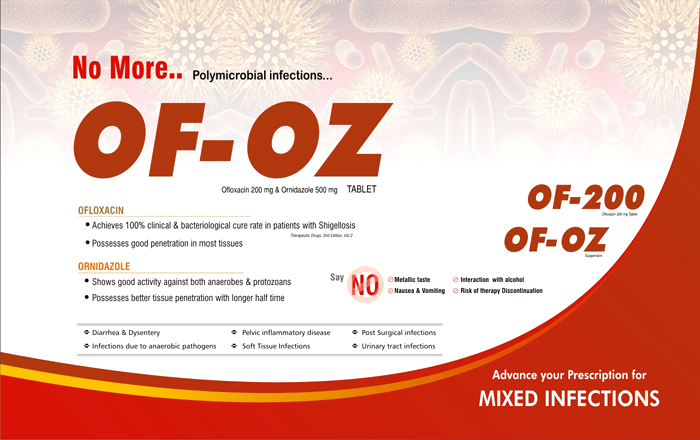Ofloxacin and Ornidazole are two prescription antibiotics that can be used either separately or combined to fight certain infections. When both are needed, there is a one pill combination of the two medications to make taking both more convenient. Your doctor can decide based on your infection, which treatment is best. These drugs are not recommended for those who are allergic to either drug or at risk for a reaction to any of the quinolone antibiotics. This article will help you understand the uses for each drug, uses for the combined therapy plus, side-effects and risks.

Ofloxacin and Ornidazole
In order to understand treatment with the combination therapy of these two drugs, let’s take a look first at each of them individually to understand what each is used for:
Ofloxacin
Ofloxacin is a fluoroquinolone antibiotic used to fight off bacterial infections in your body. This type of antibiotic treats things likebladder infections, kidney infections, skin, lung, and prostate infections. It is also used in ear infections. Other conditions it treats are chlamydia, gonorrhea, and pelvic inflammatory disease.
There are other uses “off label” that Ofloxacin is used for, includingTuberculosis (not approved by the FDA), corneal inflammation when given before eye surgery, and mycoplasma pneumonia.
Ornidazole
This medication is used for certain infections that are caused byanaerobic bacteria (not requiring oxygen), amoebic, and parasitic infections. These infections are commonly found in the urinary tract, vagina, and the intestines. The antibiotic may also be given to prevent these types of infections.
Some of the common infections this medication treats are amoebic dysentery, bacterial vaginosis, Trichomoniasis, giardiasis, hepatic amoebas, and off-label for Crohn’s Disease.
Ofloxacin and Ornidazole Combination Uses
- Doctors use a combination of Ofloxacin and Ornidazole for infections in the digestive tract that lead to abdominal pain and diarrhea. This combination treats amoebic and protozoan infections.
- It also treats parasitic and fungal infections in oral cavity or vagina.
- The combination is often very effective when you have a urinary tract infection.
- It is also helpful to use this combination when respiratory infections are caused by very aggressive bacteria like pneumonia and bronchitis. The doctor may use this medication in a “short burst” over the course of 3 to 5 days.
- It is also helpful in bringing some sexually transmitted diseases (STD) under control. Severe cases of Chlamydia and Gonorrhea can be treated in short courses with high doses of this combination to eradicate the infection quickly. Some cases of STD’s fail therapy because the patient stops taking the antibiotics. This combination can work to clear these infections in just a few doses. This eliminates the chance of reoccurrence or drug resistance because the course of treatment is easier and faster to complete.
- Leprosy, also known as “Hansen’s Disease” is caused by a very hard to kill bacteria. It was once very contagious, but combination therapies like Ofloxacin and Ornidazole can help eradicate the infection. Sometimes this combination is combined with other drugs to shorten the time of treatment and can reduce the risk of transmission of Leprosy to others.
Dosage for Ofloxacin and Ornidazole
- Adults: The combination tablets of Ofloxacin and Ornidazole come in a single dose tablet containing200mg of Ofloxacin and 500mg Ornidazole.
- The usual adult dosage is: One tablet taken twice daily for 5 to 10 days depending on the severity of the infection.
- Children (under 8 years old): The combination comes in a suspension for children under 8 years old. This contains 50mg Ofloxacin and 125mg Ornidazole per 5 ml of suspension. The usual dosage for children under 8 years old is 2.5 ml to 5 ml two times a day. Your doctor will determine the proper dose based on your child’s weight.
Precautions for Ofloxacin and Ornidazole
- Pregnancy: This combination is a category C pregnancy drug, which means it may or may not harm a fetus. You need to ask your doctor about the safety of this medication during pregnancy and let your doctor know if you plan on or are pregnant if you are being prescribed this drug.
- Breastfeeding: Researchers are not sure if this combination passes into breast milk. Use a supplemental formula while taking this medication for your baby’s safety.
- Pediatric Use: This drug should only be prescribed by your child’s doctor and only used as long as it is needed and in the smallest dose to eradicate the infection.
What Are the Side-Effects of Ofloxacin and Ornidazole?
Each individual drug has side-effects and the combination poses some different risks and side-effects. Regulatory agencies warn against “off-label” uses of these drugs due to increased risks of adverse events. This combination should only be used for the intended purpose and only when absolutely necessary. Side effects by drug include:
Ofloxacin Side-Effects
- Nausea
- Diarrhea
- Headaches
- Dizziness
- Insomnia
- Rash that looks like sunburn
- Fever
- Sore Throat
- Fatigue
- Yellow skin and eyes
- Anxiety
- Confusion
- Fast heartbeat
- Mood changes
- Tingling of the hands and feet
- Yeast Infection
- Severe allergic reactions (hives, trouble breathing, swelling of the face)
Ornidazole Side-Effects
When you take these two medications together in combination, the risk of side-effects above are increased and a few new side-effects may occur includingsensitivity to light, tendon rupture or tendinopathy, abdominal pain, abnormal heart rhythm (prolonged QT syndrome), development of the neurological disorder myasthenia gravis, and Clostridium difficile. Some of these severe adverse effects seemed to occur when the medication(s) were used in conjunction with corticosteroids.
- Excessive sleepiness
- Headache
- Nausea
- Vomiting
- Dizziness
- Tremor
- Muscle stiffness
- Uncoordinated movements
- Seizures
- Feeling tired
- Vertigo
- Loss of consciousness
- Numbness in hands and feet
- Altered taste
- Skin reactions
- Abnormal liver function tests
